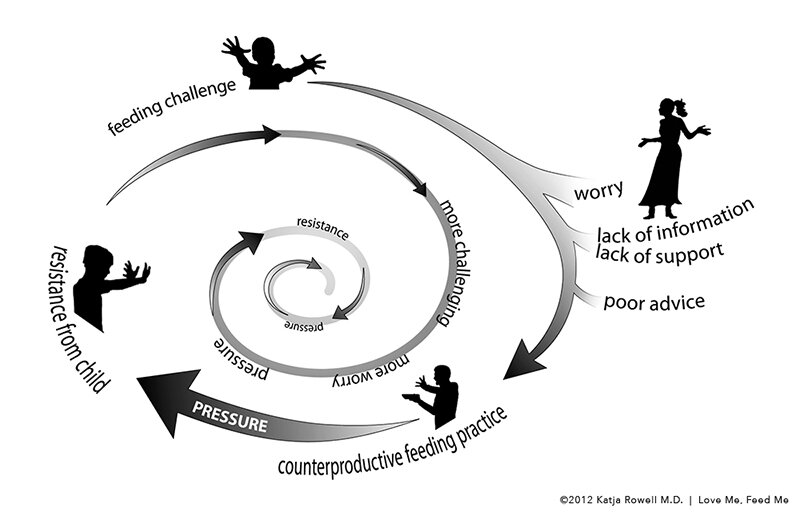ARE YOU…
Anxious about your child’s nutrition?
Frustrated with confusing and unhelpful advice?
Trying, and failing, to get your child to eat more, less, or different foods?
Worried about your child’s growth or weight?
Whether your child is a typical selective eater (describes a third to half of all young children) or anxiously eats only a handful of accepted foods, this book has you covered.
Help your child do their best with eating, with trauma-informed guidance. Learn how a focus on felt safety (calm) and connection supports physical and mental health and well-being, and over time, improved nutrition.
A responsive feeding philosophy decreases conflict and power struggles around food and sets the stage for your child to tap into curiosity, and hunger and fullness cues. Support tuned-in eating (interoception) and self-regulation.
From infancy through the teen years, with a focus on toddler to school age. Flexible and practical support attuned to children with sensitive nervous systems or feeding differences and challenges.
*Print version is preferred, with diagrams, graphs, and tables illustrating more complex ideas. When Mealtimes are Hard is adapted from Love Me, Feed Me, with foster and adoption-specific information removed and substantial overlap in content.
When Mealtimes Are Hard helps with:
picky eating from mild to extreme
feeding children with sensory and nervous system differences
anxiety around food
food preoccupation
menu planning for different needs, including your own
lowering the risk of eating disorders
supporting your child to tune in to hunger and fullness
supporting higher-weight children

Understand your challenges and discover practical solutions that work for your family.
“I actually look forward to eating with my kids.”
—Martin, dad
“I’ve been able to support my autistic daughter to discover foods she wants to eat - without pressure - and ease the anxiety for us both.”
—Amber, mom
“I will recommend it to clients. I love how Dr. Rowell describes a flexible approach and explains the nuances behind concepts and strategies that we sometimes take for granted. She invites us to think less about what strategies are “right” or “wrong,” “helpful” or “unhelpful,” and more about how to respond to an individual’s needs so they feel safe and loved and can reach their potential with eating.”
—Hazel Wolstenholme PhD, child feeding specialist
This is a book you can dip into again and again; with an extensive index (print version) and clear headings to help you find what you need. Quotes from parents, teens, and young adults are in italics throughout, as parents have shared that hearing from others who have been there is critical on this journey.
Research tells us that when you understand why your child struggles, it reduces anxiety and empowers you to feel more confident and capable. The book opens with foundational concepts around eating, appetite, felt safety and the brain-body connection, hunger, how kids learn to eat variety, and how sensory differences and anxiety impact eating.
An overview of responsive feeding including flexible structure, autonomy-supporting practices, and menu planning is established before deeper dives into avoidant eating and food preoccupation. Misperceptions around weight, growth, and nutrition are addressed throughout. Learn about modified baby-led weaning, choosing a cup, seating, utensils, and more. Basic info on eating disorders, nutrition worries, and supporting your own resilience wraps it up.
The Worry Cycle
Described by parents as the “black hole,” or “circling the drain,” the Worry Cycle can be a difficult place to come back from. Anticipate challenges and avoid the cycle; and get out of counterproductive cycles of pressure and restriction.
This image may be used as long as it is unchanged and the copyright is included.
Download Resources
Food Preference List
First appearing in Conquer Picky Eating for Teens and Adults, this is for picky and avoidant eaters: thinking about foods that have been eaten, or that you or your child may want to try again. The list is comprehensive; filling it out can empower teens and adults, as well as offer ideas for new ways to serve and experiment with foods.
Lunch Box Card
Developed when Rowell’s daughter hit preschool, the original lunchbox card can help protect your child from pressure at school and away from home. Print, fill in, laminate, and place it in your child’s lunch. Tell them that if an adult asks them to eat certain foods or in a certain order, they can point to or hand over the card.
Food Intake Journal
“We did a food diary before. How is this different?” Standard nutrition intakes offer only a small part of the picture - the what and how much. This Intake Journal goes deeper, uncovering opportunities for healing. Explore patterns with structure, what you are offering, and interactions. Use as a companion with the books or with your helping professional.
Brain Body Connection Diagram
As you explore the diagram, consider that nervous system regulation does as much, if not more, for heart and physical health as vegetables. A focus on felt safety and connection does not ignore health; it’s the foundation.
Photo by Annie Spratt on Unsplash
More Resources
For a list of products, books, and websites mentioned in the book, as well as links around food preoccupation, avoidant eating and more.





